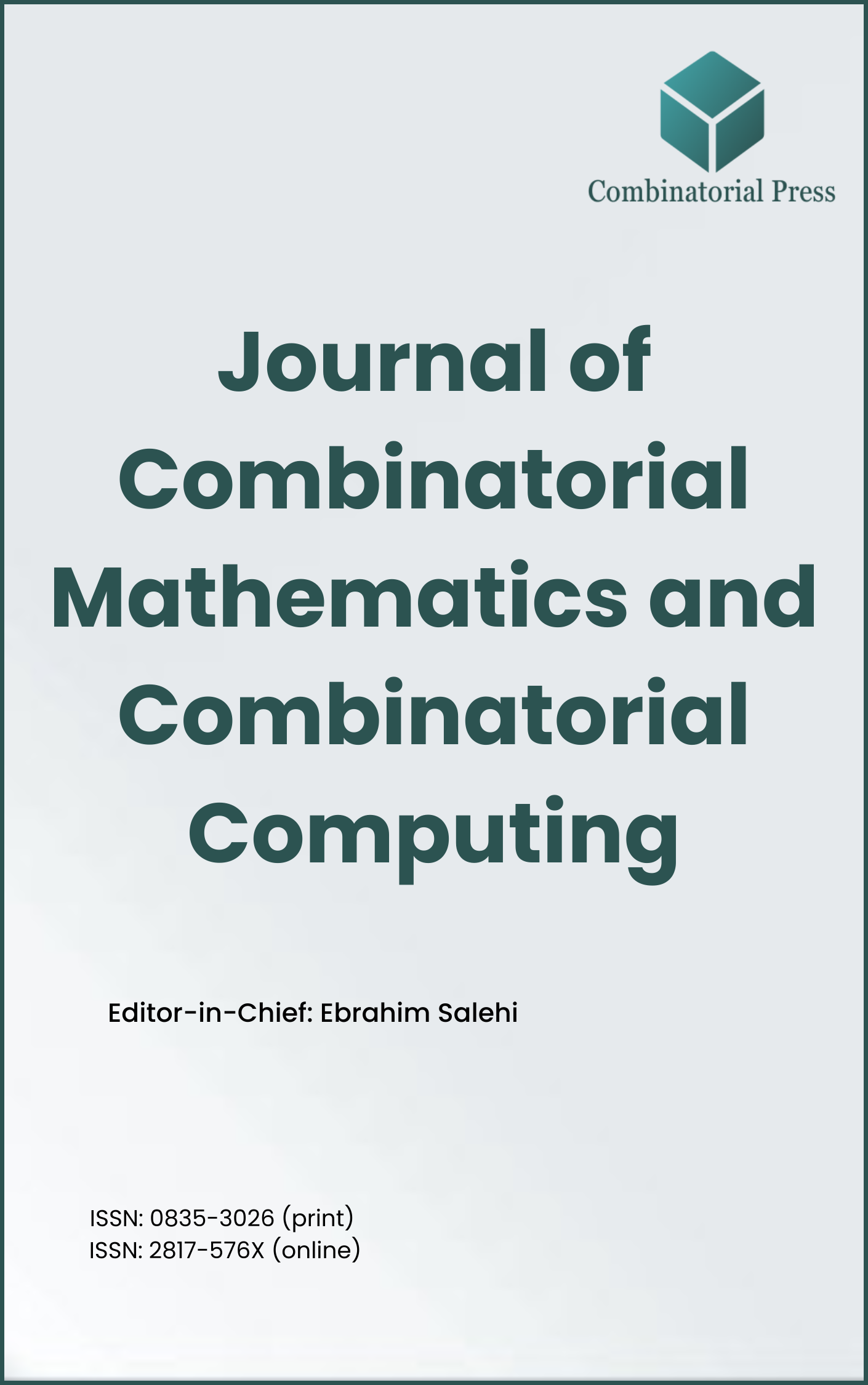
Journal of Combinatorial Mathematics and Combinatorial Computing
ISSN: 0835-3026 (print) 2817-576X (online)
The Journal of Combinatorial Mathematics and Combinatorial Computing (JCMCC) embarked on its publishing journey in April 1987. From 2024 onward, it publishes four volumes per year in March, June, September and December. JCMCC has gained recognition and visibility in the academic community and is indexed in renowned databases such as MathSciNet, Zentralblatt, Engineering Village and Scopus. The scope of the journal includes; Combinatorial Mathematics, Combinatorial Computing, Artificial Intelligence and applications of Artificial Intelligence in various files.
- Research article
- Full Text
- Journal of Combinatorial Mathematics and Combinatorial Computing
- Volume 014
- Pages: 211-215
- Published: 31/10/1993
A weight
- Research article
- Full Text
- Journal of Combinatorial Mathematics and Combinatorial Computing
- Volume 014
- Pages: 193-210
- Published: 31/10/1993
In this paper we prove that a
- Research article
- Full Text
- Journal of Combinatorial Mathematics and Combinatorial Computing
- Volume 014
- Pages: 173-182
- Published: 31/10/1993
For a wide range of
- Research article
- Full Text
- Journal of Combinatorial Mathematics and Combinatorial Computing
- Volume 014
- Pages: 153-171
- Published: 31/10/1993
Necessary conditions for the existence of group divisible designs with block size three are developed. A computation is described that establishes the sufficiency of these conditions for sixty and fewer elements.
- Research article
- Full Text
- Journal of Combinatorial Mathematics and Combinatorial Computing
- Volume 014
- Pages: 145-152
- Published: 31/10/1993
Four
Consequently, there exist
- Research article
- Full Text
- Journal of Combinatorial Mathematics and Combinatorial Computing
- Volume 014
- Pages: 137-144
- Published: 31/10/1993
For a nonempty subset
- Research article
- Full Text
- Journal of Combinatorial Mathematics and Combinatorial Computing
- Volume 014
- Pages: 97-135
- Published: 31/10/1993
This paper studies the problem of allocating interacting program modules, of a distributed program, to the heterogeneous processors in a distributed computer system. The interacting program/task modules are represented by an undirected task graph, whose vertices denote task modules and edges denote interactions between modules. We are given the execution cost of a task module on each processor, the communication cost between two task modules if they are placed on different processors, and the interference cost between two task modules if they are placed on the same processor. The objective of our problem is to assign task modules to the processors such that the total of the above three costs incurred by the program on the system is minimized. The above task assignment problem is known to be NP-hard for a three processor system, but its complexity for a two processor system remained open. In this paper we prove that the problem remains NP-hard for a two processor system even when (1) task graph is planar and has maximum degree
- Research article
- Full Text
- Journal of Combinatorial Mathematics and Combinatorial Computing
- Volume 014
- Pages: 87-96
- Published: 31/10/1993
Let
- Research article
- Full Text
- Journal of Combinatorial Mathematics and Combinatorial Computing
- Volume 014
- Pages: 79-85
- Published: 31/10/1993
Consider the problem of computing a stabber for polygonal objects. Given a set of objects
- Research article
- Full Text
- Journal of Combinatorial Mathematics and Combinatorial Computing
- Volume 014
- Pages: 65-77
- Published: 31/10/1993
A secret sharing scheme protects a secret (key) by distributing related information among a group of participants. This is done in such a way that only certain pre-specified groups of these participants (the access structure) can reconstruct the secret. In this paper, we introduce a new measure of the efficiency of a perfect secret sharing scheme and examine methods of producing new secret sharing schemes from existing ones. These constructions can be used to help determine the optimal information rates for certain access structures.





